Search results for: 'glas'
-
 Durchsichtiges römisches Unguentarium
Durchsichtiges römisches UnguentariumBirnenförmiger Körper, nach oben wieder breiter werdender Hals. Filigrab gearbeitetes, absolut durchsichtiges Glas. Höhe 5 cm, 1. - 3. Jh. n. Chr.
Price: on request Roman glass beaker
Roman glass beakerThis beaker type was popular in the Holy Land during the time of Jesus Christ. But products of the local workshops were also exported.
Price: on request Kegelförmige Glasflasche
Kegelförmige GlasflascheAntikes römisches Glasfläschchen, Naher Osten. 90mm hoch. Vermutlich für Öl oder Parfüm verwendet. Kräftige Fundpatina.
Price: on request Durchschimmerndes antikes Glasfläschchen
Durchschimmerndes antikes GlasfläschchenRömisches Glasfläschchen. Seltener Typ aus fast farblosem, durchschimmernden Glas. Levante, 1. bis 4. Jh. n.Chr.
Price: on request Two Roman glass unguentaria
Two Roman glass unguentariaThe early imperial perfume bottles are from the eastern Mediterranean. Acquired in 1974 from art dealer Albrecht Neuhaus.
Price: on request Roman ribbed glass bowl
Roman ribbed glass bowlOf beautiful, thick-walled glass of a bright light green color. The glass was mold made in a Roman factory of the eastern Mediterranean.
Price: on request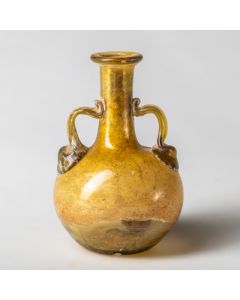 Roman glass bottle with handles
Roman glass bottle with handlesThe glass impresses with its elegant shape. Made in one of the Roman glass factories in the eastern Mediterranean during the Late Imperial period.
Price: on request Early Islamic glass with spiral thread
Early Islamic glass with spiral threadA marvelous example for Early Islamic glass after the conquest of the Levant, during Umayyad rule. A glass from the professor Ritschel collection.
Price: on request Roman glass juglet
Roman glass jugletThe small jug with a pear-shaped body is outstanding due to the strongly iridescent patina and the dark coating on the outside. From the Late Roman Imperial period.
Price: on request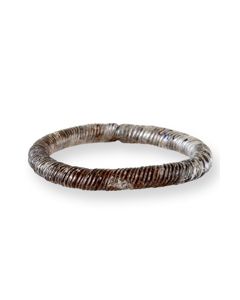 Roman glass bracelet with spiral decoration
Roman glass bracelet with spiral decorationThe 4th century bangle is decorated with spiraling grooves on the outside. Made in the Eastern Mediterranean.
Price: on request Late Roman glass flask
Late Roman glass flaskFlat bottle with double handle from the Eastern Mediterranean. Made between the 3rd and 6th century.
Price: on request Roman glass bracelet with spiral decoration
Roman glass bracelet with spiral decorationThe 4th century bangle is decorated with spiraling grooves on the outside. Made in the Eastern Mediterranean.
Price: on request Roman glass bottle with handle
Roman glass bottle with handleThe cylindrical vessel has a nice iridescent patina. Made between 50 and 200 AD on the Black Sea coast or in the Near East.
Price: on request Roman glass bracelet with spiral decoration
Roman glass bracelet with spiral decorationThe 4th century bangle is decorated with white spiraling glass inlay. Made in the Eastern Mediterranean.
Price: on request Roman glass beaker
Roman glass beakerRare cup made of almost colourless glass. A 4th century product from the eastern Mediterranean.
Price: on request Roman jug made of aubergine glass
Roman jug made of aubergine glassBeautiful glass with a violet colour. From the Roman Imperial period.
Price: on request Roman globular glass bottle
Roman globular glass bottleBeautifully decorated with bands of incised decorative grooves. Spherical body and funnel-shaped neck.
Price: on request Byzantine glass pendant from Judaea
Byzantine glass pendant from JudaeaThe pendant with a lion and crescent motif was worn as a lucky charm or protective amulet. Made in the early Byzantine period in a glass workshop in Judaea.
Price: on request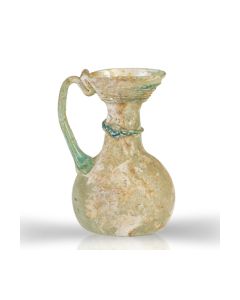 Roman glass pitcher
Roman glass pitcherFine and beautifully decorated glass pitcher from Roman Palestine, probably from an ancient workshop in what is now Jalamah. Around 500 AD.
Price: on request Byzantine glass pendant from Judaea
Byzantine glass pendant from JudaeaThe pendant shows Romulus and Remus being suckled by a she-wolf. It was worn as a lucky charm or protective amulet. Made in the early Byzantine period in a glass workshop in Judaea.
Price: on request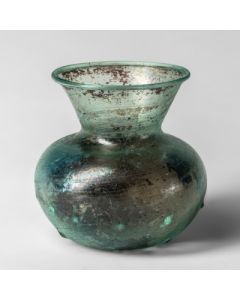 Roman glass vessel with knobs
Roman glass vessel with knobsA rare and impressive vessel type from a late Roman glass factory in the Levant. Dating from the 3rd to 4th century.
€1,080 Necklace of Egyptian mosaic glass beads
Necklace of Egyptian mosaic glass beadsModernly threaded necklace of ancient beads made of beautiful mosaic glass and sheet gold. The mosaic originated in a workshop in Roman Egypt. Ex Christie's.
Price: on request Roman globular bottle
Roman globular bottlePerfectly preserved glass vessel with globular body. Made in the Eastern Mediterranean during late Roman Imperial times.
Price: on request Sidonian perfume bottle
Sidonian perfume bottleGlass from Sidon with a decorative relief of amphorae and other vessels. A phoenician production from the 1st century AD.
Price: on request Scaraboid with horseman hunting lion
Scaraboid with horseman hunting lionThis stunning stamp seal is from the First Persian Empire of the Achaemenids or from parts under Greek control. 5th to 4th cent. BC.
Price: on request Roman sprinkler
Roman sprinklerPerfume bottle with pattern-blown body. An aperture made it easy to dispense the precious content drop by drop. From the Late Roman period.
Price: on request Phoenician eye bead
Phoenician eye beadPolychrome glass bead with stylized elements of a face as protection against the evil eye. Produced in Carthage or the Phoenician homeland, 4th to 3rd century BC.
Price: on request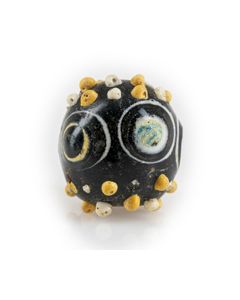 Large Phoenician eye bead
Large Phoenician eye beadDark and unusually large glass bead with stylized elements of a face as protection against the evil eye. Produced in Carthage or the Phoenician homeland, 4th to 3rd century BC.
Price: on request Phoenician eye bead
Phoenician eye beadPolychrome glass bead with stylized elements of a face as protection against the evil eye. Produced in Carthage or the Phoenician homeland, 4th to 3rd century BC.
Price: on request Phoenician eye bead
Phoenician eye beadPolychrome glass bead with stylized elements of a face as protection against the evil eye. Produced in Carthage or the Phoenician homeland, 4th to 3rd century BC.
Price: on request Phoenician eye bead
Phoenician eye beadPolychrome glass bead with stylized elements of a face as protection against the evil eye. Produced in Carthage or the Phoenician homeland, 4th to 3rd century BC.
Price: on request Phoenician eye bead
Phoenician eye beadPolychrome glass bead with stylized elements of a face as protection against the evil eye. Produced in Carthage or the Phoenician homeland, 4th to 3rd century BC.
Price: on request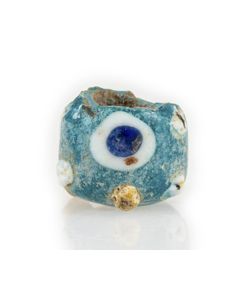 Phoenician eye bead
Phoenician eye beadPolychrome glass bead with stylized elements of a face as protection against the evil eye. Produced in Carthage or the Phoenician homeland, 4th to 3rd century BC.
Price: on request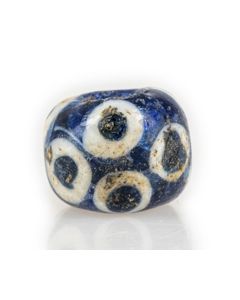 Phoenician eye bead
Phoenician eye beadPolychrome glass bead with stylized elements of a face as protection against the evil eye. Produced in Carthage or the Phoenician homeland, 4th to 3rd century BC.
Price: on request Phoenician eye bead
Phoenician eye beadPolychrome glass bead with stylized elements of a face as protection against the evil eye. Produced in Carthage or the Phoenician homeland, 4th to 3rd century BC.
Price: on request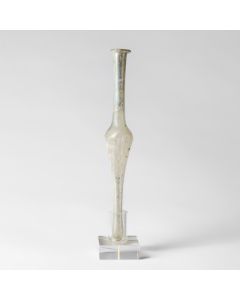 Spindle shaped Roman unguentarium
Spindle shaped Roman unguentariumA tall and slender glass vessel made of almost colourless glass. Similar finds from the 4th century are known from the Balkans and Cyprus.
€950

